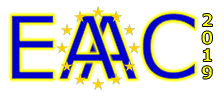Speaker
Description
Being promising alternatives to conventional accelerators and for application to high-energy physics also linear colliders, it is crucial for plasma accelerators to accelerate positrons, which is much more challenging than electron acceleration that most current researches focus on.
Plasma electron motion is one main source of beam quality degradation for positron acceleration in quasi-linear regime of plasma wakefield acceleration. We study the evolution of a positron witness bunch starting from matched condition in wakefield generated by a drive bunch. For relatively high witness charge, the witness projected emittance can initially grow and rapidly saturate due to non-linear transverse focusing force of loaded wakefield. But it is found that the relative emittance growth stays moderate and that negligible emittance growth occur after equilibrium reached. However, beam loading creates a longitudinal accelerating field that varies both longitudinally and transversely, and generates significant slice correlated energy spread, which grows continuously over propagation distance. The degradation of longitudinal phase space sets a limit on the witness charge that can be accelerated in quasilinear plasma wakefield, which also limits the efficiency of the accelerator. It is found that efficiencies of up to 20% can be obtained for a positron plasma wakefield accelerator in quasi-linear regime.

